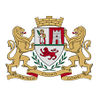Kotor
| Kotor Котор |
|||
|---|---|---|---|
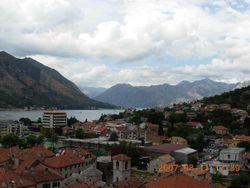 |
|||
|
|||
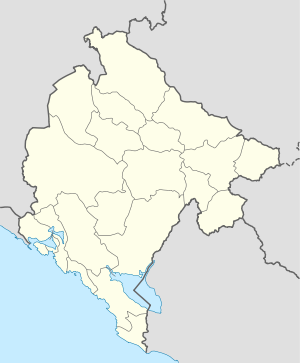 Kotor
|
|||
| Coordinates: | |||
| Country | |||
| Founded | 5th Century B.C. | ||
| Settlements | 56 | ||
| Government | |||
| - Mayor | Marija Ćatović (DPS) | ||
| Area | |||
| - Municipality | 335 km2 (129.3 sq mi) | ||
| Population (2003 census) | |||
| - Total | 5,341 | ||
| - Density | 68/km2 (176.1/sq mi) | ||
| - Municipality | 22,947 | ||
| Time zone | CET (UTC+1) | ||
| - Summer (DST) | CEST (UTC+2) | ||
| Postal code | 85330 | ||
| Area code | +382 32 | ||
| ISO 3166-2 code | ME-10 | ||
| Car Plates | KO | ||
| Website | www.opstinakotor.com | ||
Kotor (Montenegrin: Котор / Kotor; Latin: Acruvium; Greek: Ασκρηβιον, Askrèvion; Italian: Cattaro) is a coastal town in Montenegro. It is located in a most secluded part of Gulf of Kotor. The town has a population of 13,510, and is the administrative center of the Kotor municipality.
The old Mediterranean port of Kotor, surrounded by an impressive city wall built by Republic of Venice and the Venetian influence remains dominant among the architectural influences. The Bay of Kotor (Boka Kotorska), one of the most indented parts of the Adriatic Sea is sometimes called the southern-most fjord in Europe (though it is actually a submerged river canyon). With the nearly overhanging limestone cliffs of Orjen and Lovćen one of the great Mediterranean landscapes is created.
In recent years, Kotor has seen a steady increase in tourists attracted by both the natural beauty of the Gulf of Kotor and the old town of Kotor itself.
Kotor is part the World Heritage Site Natural and Culturo-Historical Region of Kotor.
Contents |
History
Kotor, first mentioned in 168 BC, was settled during Ancient Roman times, when it was known as Acruvium, Ascrivium, or Ascruvium and was part of the Roman province of Dalmatia.
Kotor has been fortified since the early Middle Ages, when Emperor Justinian built a fortress above Acruvium in AD 535, after expelling the Goths, and a second town probably grew up on the heights round it, for Constantine Porphyrogenitus, in the 10th century, alludes to Lower Kotor. The city was plundered by the Saracens in 840. Until the 11th century the Dalmatian language was spoken in Kotor.
In 1002, the city suffered damage under occupation of the First Bulgarian Empire, and in the following year it was ceded to Serbia by the Bulgarian Tsar Samuil. However, the local population resisted the pact, and taking advantage of its alliance with the Republic of Ragusa only submitted in 1184, while maintaining its republican institutions and its right to conclude treaties and engage in war. It was already an episcopal see, and, in the 13th century, Dominican and Franciscan monasteries were established to check the spread of Bogomilism. In the 14th century commerce in Kotor, as the city was then called, rivalled that of the nearby Republic of Ragusa and Venice. Kotor was part of the Venetian Albania province of the Venetian Republic from 1420 to 1797, except for periods of Ottoman rule between 1538-1571 and 1657-1699. Four centuries of Venetian domination have given the city the typical Venetian baroque architecture that contributed to make Kotor a UNESCO world heritage site.
While under Venetian rule, Kotor was besieged by the Ottoman Empire in 1538 and 1657, enduring the plague in 1572, and was nearly destroyed by earthquakes in 1563 and 1667. After the Treaty of Campo Formio in 1797, it passed to the Habsburg Monarchy. However, in 1805, it was assigned to the French Empire's client state, the Napoleonic Kingdom of Italy by the Treaty of Pressburg. After the Russians retreated, Kotor was united in 1810 with the French Empire's Illyrian Provinces. Kotor was then captured by British naval Captain William Hoste with his ship HMS Bacchante (38 guns). Working jointly with Montenegran forces he attacked the mountain fortress, hauling cannons and mortars to positions above the fort using block and tackle. The French garrison had no alternative but to surrender, which it did on 5 January 1814.
It was then restored to the Austrian Empire by the Congress of Vienna.
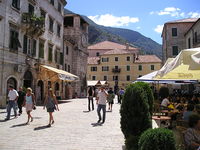
In World War I, Kotor was one of three main bases of the Austro-Hungarian Navy and homeport to the Austrian Fifth Fleet consisting of pre-dreadnought battleships and light cruisers. The area was the site of some of the fiercest battles between local Montenegrin Slavs, and Austria-Hungary. After 1918, the city (called Cattaro until then) became a part of Yugoslavia and officially became known as Kotor. Between 1941 and 1943 Italy annexed the area of Kotor to the Italian "Governorship of Dalmatia", but after 1945 it became a part of the then Socialist Republic of Montenegro within Yugoslavia's second incarnation.
In 1979 (April 15) a major earthquake hit the Montenegrin coastal area. There were approximately 100 casualties. Half of Kotor's Old Town was destroyed and St. Tryphon's Cathedral was partly damaged.
Up until the beginning of the 20th century, Catholics constituted the majority around the Gulf of Kotor.
Kotor is still the seat of the Croatian Catholic Bishopric of Kotor, which covers the entire gulf.
Population
| Kotor, part of the Natural and Culturo-Historical Region of Kotor* | |
|---|---|
| UNESCO World Heritage Site | |
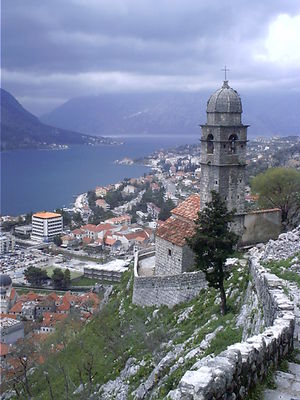 |
|
| State Party | |
| Type | Cultural |
| Criteria | i, ii, iii, iv |
| Reference | 125 |
| Region** | Europe and North America |
| Inscription history | |
| Inscription | 1979 (3rd Session) |
| Extensions | 1979-2003 |
| * Name as inscribed on World Heritage List. ** Region as classified by UNESCO. |
|
Kotor is the administrative centre of Kotor municipality, which includes towns of Dobrota, Risan and Perast, as well as many small hamlets around the Bay of Kotor. The municipality has a population of 23,481 (2003. census). The town of Kotor itself has 5,341, but Kotor and Dobrota are practically one town, they have combined population of 13,510.
Population of Kotor (Including Dobrota):
- March 3, 1981 - 10,780
- March 3, 1991 - 12,903
- November 1, 2003 - 13,510
Ethnic groups (1991 census):
- Montenegrins (55.24%)
- Serbs (14.07%)
- Croats (7.23%)
Ethnic groups (2003 census) - 22,947:
- Montenegrins - 10,741 (46.81%)
- Serbs - 7,094 (30.91%)
- Croats - 1,762 (7.68%)
- Yugoslavs - 168 (0.73%)
- Muslims - 106 (0.46%)
- Albanians - 76 (0.33%)
- Macedonians - 49 (0.21%)
- Romas - 48 (0.21%)
- Russians - 39 (0.17%)
- Slovenes - 35 (0.15%)
- Italians - 32 (0.14%)
- Hungarians - 32 (0.14%)
- Egyptians - 20 (0.09%)
- Bosniaks - 16 (0.07%)
- Germans - 14 (0.06%)
- others - 133 (0.58%)
- undeclared/undefined - 2,165 (9.43%)
- regionally affiliated - 202 (0.88%)
- no data - 215 (0.94)
According the documents from 1900, Kotor had = 7,617 Catholics, 7,207 Orthodox Christians.
Kotor is still the seat of the Catholic Bishopric of Kotor, which covers the entire gulf.
The 2003 census listed 23,481 citizens, of whom 78% were Orthodox Christians and the rest are 13% Roman Catholic.
Notable persons

- Rambo Amadeus, Montenegrin singer and songwriter
- Tomislav Crnković, Croatian footballer
- Zoran Gopčević, Montenegrin waterpolo player
- Vasko Lipovac, Croatian painter
- Ratimir Martinović, pianist
- Vlaho Orlić, Montenegrin waterpolo coach
- Andrija Paltašić, painter
- Nina Petković, Montenegrin singer and television personality
- Danilo Saveljić, Slovenian footballer
- Viktor Vida, Croatian writer
- Boško Vuksanović, Montenegrin waterpolo coach
Tourism
Kotor is one of major tourist destination in Montenegro. It has one of the best preserved medieval old towns in the Adriatic and is a UNESCO world heritage sites. It has numerous other sights, such as the Cathedral of Saint Tryphon in the old town (built in 1166), and ancient walls which stretch 4.5 kilometres (2.8 mi) directly above the city. Sveti Đorđe and Gospa od Škrpijela islets off the coast of Perast are also among the more popular destinations in the vicinity of Kotor.
The old town is filled with bars, restaurants and cafes, and there are many nightclubs in Kotor. Summer events, such as Summer Carnival or Bokeljska Noć, are visited by thousands of tourists. These are the most visited happenings in Montenegro during the summer, with over 30,000 people partying in Kotor during Summer Carnival. Kotor with Budva hosted the Federation of European Carnival Cities (FECC) World Carnival City Congress in May 2009
Kotor is not a premium destination for sunbathing, as there are no sandy beaches and the water is not of reasonable quality in this part of the Bay of Kotor. However, some of the beaches on the Budva Riviera are no more than half an hour's drive away.
Transport
Kotor is connected to the Adriatic Motorway and the rest of the coast and inland Montenegro by Vrmac Tunnel. Inland is reachable by detouring from Adriatic motorway at Budva or Sutomore (through Sozina tunnel). There is also a historic road connecting Kotor with Cetinje, which offers spectacular views of the Kotor bay.
Tivat Airport is 5 kilometres (3.1 mi) away, and there are regular flights to Belgrade and Zürich, and dozens of charter planes land daily on Tivat airport during the summer season.
Podgorica Airport is 65 kilometres (40 mi) away, and it has regular flights to major European destinations throughout the year.
References
External links
- UNESCO: Natural and Culturo-Historical Region of Kotor
- Kotor City Gide - Hotels - Accommodation Rent a Car
- Boka Kotorska Photo Gallery
- Tourist Presentation of Kotor
- Foundation for Culture and Tradition of Boka Kotorska "Project Rastko-Boka" in Serbian
- Old Town Map (1944px × 2592px 851.58 Kb JPG)
- Foundation for Culture and Tradition of Boka Kotorska "Project Rastko-Boka" in Serbian
- Kotor on the photographs of Stevan Kordić
|
|||||||

